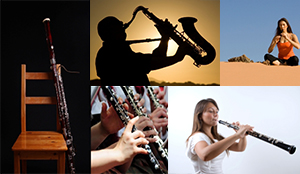
Benefits
- Develops hand-eye coordination better than sports.
- Builds confidence and self-esteem.
- Excellent ear training for pitch.
- Improves memory, intelligence and children’s behavior
- Increases brain function and mathematical skills.
- Develops discipline, patience, determination and perseverance.
75% of Silicon Valley CEOs had instrumental music education as a child.
Recommended starting age: 10—as young as 6 for recorder
Equipment needed: Clarinet, oboe, bassoon, recorder or saxophone—renting is an excellent option for most woodwind instruments as even student models can be quite expensive and some inexpensive instruments sold are unreliable, or even unplayable. Recorders, however, are very inexpensive
Practice time: 15-20 minutes per day for beginners, increasing over time to at least an hour per day.
Recommended lesson length:
- Age 6-11, 30 minutes
- Above age 11, 60 minutes
Pricing:
- 30 minute private lesson once each week $136 per month
- 60 minute private lesson once each week $256 per month
We recommend age 10 as a great age to start learning any woodwind instrument. Children need to have all of their adult teeth, be strong enough to hold up the instruments—some, like saxophone, can be quite heavy—and have enough lung capacity to blow through the instrument consistently. Recorder, of course can be started much younger and is a great starter instrument for any other woodwind instrument—although, a recorder can also be played at a very high, professional level.
Private lessons in conjunction with school music programs are a great way for students to get the individual attention they need to play well. Band and orchestra directors appreciate students that study privately, as they have limited time for any one student. Most bands and orchestras have anywhere from 50, to over 100 members. Individual instruction is, by necessity, extremely limited.
You’ll want to have a good quality, student model instrument to practice at home and play at your lessons.
All students learn to read music. Teachers will devise a customized curriculum for each student which will incorporate the style of music that the student wants to learn in addition to teaching music theory, history and other appropriate musical skills.
